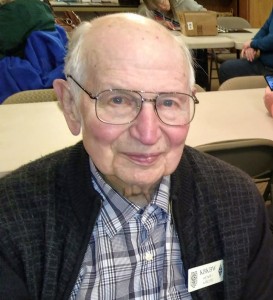BY JOEL THURTELL
She might as well have shot him herself.
The cops did the job for her.
The victim was 28-year-old McEldon Tisdel, a black man living with his family in a nearly all-white village in southwestern Michigan.
Through a closed door on July 29, 1977, an apartment manager heard what she claimed was a shotgun being pumped. That’s what she told three Berrien Springs-Oronoko Township cops. Two cops backed by a third fired eight bullets into Tisdel where he sat in a chair in his apartment. The cops kicked his family out of the apartment and, according to the Tisdel family’s attorney, held off calling for an ambulance while they arranged “evidence.”
The Berrien County prosecutor ruled it “justifiable homicide.”
I found my file on the Tisdel case last year as I was preparing to teach a Wayne State University class on investigative reporting. For the class, I was preparing a workbook containing exercises that would help students practice at investigative reporting. I wanted them to understand that investigative journalism requires forms of questioning that may challenge conventional thinking. I believe that unconventional questioning requires a unique state of mind that can’t be acquired by studying standard textbooks on reporting and writing news.
I wanted to encourage students to seek questions first, then apply their brains to finding answers. My workbook has a uniform format for presenting a journalistic challenge. First, there is an introductory section such as the one you are now reading. The intro is followed by a reprint of a news article. After the article, I pose a series of questions about its contents and reportorial method.
When I learned of the 2020 police murder of George Floyd, I thought of the 1977 killing of McEldon Tisdel. George Floyd’s death by police was still fresh news as we met the course over Zoom. Two of my students were demonstrating against police brutality in the streets of Detroit.
I learned about the Tisdel killing when Berrien Springs Village Council members discussed the Tisdel family’s federal lawsuit against the three cops, the apartment manager, and the village and township in a village council meeting. Tisdel’s family wanted $7 million to compensate them for what they claimed was McEldon Tisdel’s wrongful death.
I sent my stories to the South Bend Tribune. They also ran in the weekly Berrien Springs Journal Era. For my WSU students, I presented both sets of stories. You can see them here:
TISDEL POLICE SHOOTING JE SBT 5-27-2020
This is what I told my students over Zoom:
This 43-year-old news story might still contain potential as an investigative report.
The advent of cellphone cameras has made it apparent to the general public that many police shootings are unjustified.
Before cellphones, it was much harder for victims or witnesses to be believed.
Sometimes the facts of a case were so outrageous and unfair that you would think justice would be inevitable. For instance,it is not illegal for a man to rack a shotgun while sitting in a chair in his own apartment.
In 1983, the case was settled. The amount of the settlement with the Tisdel family was suppressed. However, two insurance companies sued the two governments, claiming they were not obligated to cover the damages.
While reporting the story for the Berrien Springs Journal Era and South Bend Tribune, I went to the Berrien Springs village office. I needed some official comment. Several village officials were there, including the village president. I said, “Why did the police shoot a man who was sitting in a chair in his own apartment?” There was silence. After a few seconds, Village Clerk Harold Wagner replied. “I’ll tell you why they shot him. They shot him because he was a nigger.”
Do you see differences in the Journal Era and Tribune articles? Does one paper provide more information than the other? There was one author — me. Consider this an experiment. A writer submits the same story (a constant) to two different newspapers. The resulting print versions of the story are the variables. Do the variables differ? Does one published account contain more detail than the other? Is there a pattern to the kind of information appearing in one article and omitted in the other?
Can you relate the differing treatments experienced by this same news story to the argument of Theodore L. Glasser in “Objectivity and News Bias” [see note below] that journalists see themselves as conductors of “facts” filtered through officials? Note that the source for allegations against the police is an attorney who is not a government official. Might some journalists give less credence to his statements than to comments from an official? Consider that there was no risk in publishing the lawyer’s words — his remarks paralleled his written argument in a federal lawsuit and are exempt from a libel action.
Why does the first Journal Era story on July 16, 1980 refer to the South Bend Tribune for information about the 1977 shooting? Could it be that the Journal Era in 1977 failed to cover a homicide in its own town? How would we find out if the JE covered the story?
How would we build a factual timeline for the case?
Who were the shooters?
What is a “plaintiff”? Who were the plaintiffs in the lawsuit?
Who was plaintiffs’ attorney?
What is a “defendant”? Who were the defendants?
Who is the defendants’ attorney?
Where was the lawsuit filed?
Who was the judge?
Why were two insurance companies involved?
Who was covered and not covered by insurance?
What is an “intentional tort”?
What is a “willful civil wrong”?
Why did one of the insurance companies decline to cover officers?
Why wouldn’t insurance cover more than $300,000 in damages?
What are “punitive damages”?
What does it mean to “settle” a lawsuit?
What does it mean to “suppress” a settlement?
How could we find out how much the case was settled for?
The US District Court case number is K80-440. How would one get access to the case file?
It would be good to have the case file for building our special knowledge of the circumstances, and for finding names of potential sources.
The amount of the settlement was suppressed. How might we find out that amount?
Would it be worthwhile to check news reports to see if there is mention of an amount?
Ask plaintiffs?
Ask the insurance companies?
Ask the attorneys?
If the two local governments paid money out for the settlement, they would have withdrawn money from public accounts. Could we ask to see those records? Could we look at minutes of village council and township board meetings?
[The Michigan Constitution says government financial records must be disclosed upon request. The Michigan Penal Code requires that government documents be disclosed upon request during normal business hours. Otherwise, the record-keepers could be jailed or fined.]
Possibly one or both governments assessed a special property tax levy to pay the settlement. Where would tax information be located?
I left the Journal Era in February, 1981. The case was settled two years later.
Would it be worth pursuing a 43-year-old murder case at. this time?
Would it be worthwhile to report on a civil case where the family of a black man killed by police forced those responsible to compensate them for the loss of their son’s life?
Might a story in 2020 encourage other victims’ relatives to pursue killer-cops in the courts?
Do you think Berrien Springs Clerk Harold Wagner was being a racist when he said, “they shot him because he was a nigger?”
Are there different ways to interpret Clerk Wagner’s comment? Is it possible that he used a racially-laden term to make a point? What might such a point be?
Reference
Theodore L. Glasser, “Objectivity and News Bias,” in Elliot D. Cohen, Ed., Philosophical Issues in Journalism (Oxford University Press, 1992), 176-185.

